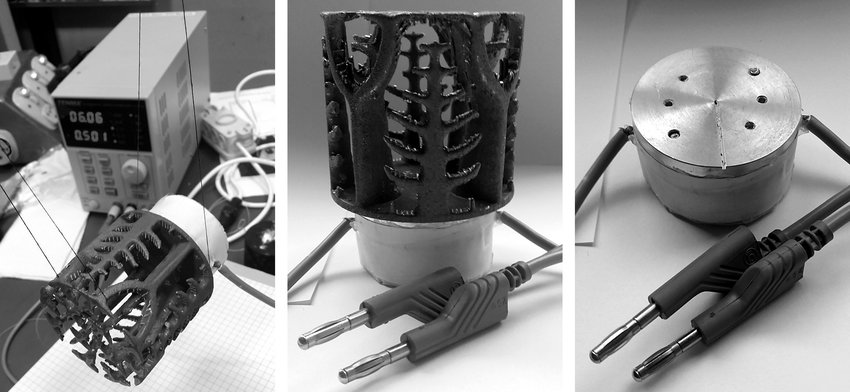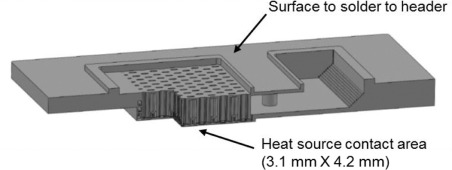You’ve probably already seen some 3D printed heatsink articles pass you by over the years, but are heatsinks a footnote or our future? In 2016, ORNL told us that, “Increased power densities in electronics will require more efficient heat sinks, and additive manufacturing combined with a simple thermal annealing process could help designers meet that goal.”
The research institute then went on to showcase genetic algorithms to make better aluminum heatsinks. Affordable metal printing startup ValCun even focuses on them in copper and aluminum. CERN has 3D printed cooler bars courtesy of 3D Systems. Companies such as TCPoly even want to use conductive polymer filaments for plastic heatsinks.
In this paper, we can see how an FDM ABS heatsink performs. In this case from 2015, we can see that an initial prototype was 3D printed in FDM and FDM was used to make parts of the test rig for the powder bed fusion heatsinks as well. In another instance, a heat exchanger insert with a wavy fin design was also made using ABS and FDM. In this case, ABS 3D printing was in part used to make a “personal cooling garment.”
Purdue University students showcased how they made a shark fin-style heat sink in which they have optimized heat transfer with three different components, including a high-performance heat sink inspired by a respirator and breathing. Their heatsink was made for computer processors but wider applications can readily be imagined.
This paper details different designs for heatsinks for LED lighting that outperform traditional counterparts. The paper indicates that, “Numerical and experimental results agree well and indicate that the obtained designs outperform lattice geometries by more than 21%, resulting in a doubling of life expectancy and 50% decrease in operational cost.” When commercially available cooling solutions are outperformed in an experiment by a topology optimized 3D printed part, it is an indication that industrial use could be in the offing.

In this IEEE paper, we can see how silicon carbide was used for optimized MOSFETs. Here a similar air cooled heat sink design was tested for electric vehicle applications. In this case, a “high-performance water-cooled micro heat sink for the thermal management of high heat flux microelectronics was designed, fabricated, and tested. The heat sink design leverages a multi- metal electrodeposition additive manufacturing process to produce complex flow which are impossible to fabricate with traditional processes.” The FINJET heat exchanger combines additive with microfluidics to bring to life a new potential class of heat exchangers and heat sinks that cannot be made in another way.

It’s not only lab rats, however. German company IQ Evolution has been 3D printing liquid-cooled and other heat sinks made with powder bed fusion since 2006! The company can make unique and series “IGBTs, MOSFETs, inductors, power modules, transistors, capacitors, PCB cooling, multilayer boards, printed PCB.” Their process also lets us now produce optimized heatsinks in Germany.

Similar to flow applications and manifolds, optimized geometry in heatsinks can provide industrial users with benefits. Heat sinks that are optimized thermally and offer the best flow, geometry and structures can be made currently. Whats more, these structures could be smaller in mass or have significantly less volume than their mass-manufactured counterparts. In super high-end applications, unique or custom heat sinks can already be found. 3D printing a heatsink can be particularly valuable when a part is traditionally combined with a heatsink or a tube. 3D printing can also be used to reduce the number of parts in the final assembly or reduce the number of process steps, which can be nice in Six Sigma environments, for example. Although more expensive than conventional heatsinks, new designs and iterations can be made more quickly with additve.
Electric vehicles, high-end computing applications, space, and defense related applications are the most obvious area for 3D printed heatsinks currently. If your satellite needs a heatsink, then a slight optimization in efficiency would be worth a lot to you. It may make your satellite cheaper to launch, extend its life or extend its functionality. At the same time, the other benefits will also carry with them significant advantages for you. Less mass, less volume, fewer parts, faster manufacturing time will all have outsized benefits for satellites and similar structures.
But, will all electric cars have 3D printed heatsinks? Generally the technology may not be ready for such volumes at such low-cost points yet. But, with cost reductions and efficiencies, there will be an expansion of this kind of activity. Binder jet, if industrialized further, may be a good candidate for such structures as well. With the increasing prevalence of aluminum in powder bed fusion, this popular heat sink material also becomes more available all the time.
What about consumer electronics, will your next laptop have a 3D printed heat sink? As of right now, this is unlikely. But, once Apple and the rest start to 3D print more antenna components, they will also realize that the same process lets them 3D print batteries and heat sinks, as well. What’s more, they can think of the phone more as a holistic device, rather than a set of components to be assembled. In that manner, a mount could become a heatsink, a battery could become a baseplate, and both could also function as an antenna.
To make this kind of production viable with Aerosol Jet or other technologies, however, would require a rather big investment by an electronics manufacturer. Apple, specifically, is not shy in making these kinds of punts into the future from time to time. For example, the unibody Macbooks were initially thought to be rather improbable for a laptop as a possibility since they each had to be made from a single block of aluminum. For over 15 years Apple hs not only been brutal, but inked long-term deals to assure the supply of key components, routinely buying out, paying upfront for or bailing out key suppliers to maintain an edge. Apple, therefore, is ruthless enough, big enough and has the gumption to bring about integrated 3D printed phone manufacturing for batteries, antenna, and heatsinks. Samsung could also do something similar, if it was important enough to the company. Whereas thinness, increased efficiency, and optimal performance are important to these giants they so far are not important enough for them to laud in the next 3D printing manufacturing revolution towards the making of billions of devices. But, I’m betting that eventually we will get there.
Subscribe to Our Email Newsletter
Stay up-to-date on all the latest news from the 3D printing industry and receive information and offers from third party vendors.
You May Also Like
Precision at the Microscale: UK Researchers Advance Medical Devices with BMF’s 3D Printing Tech
University of Nottingham researchers are using Boston Micro Fabrication‘s (BMF) 3D printing technology to develop medical devices that improve compatibility with human tissue. Funded by a UK grant, this project...
3D Printing Webinar and Event Roundup: April 21, 2024
It’s another busy week of webinars and events, starting with Hannover Messe in Germany and continuing with Metalcasting Congress, Chinaplas, TechBlick’s Innovation Festival, and more. Stratasys continues its advanced training...
3D Printing Webinar and Event Roundup: March 17, 2024
It’s another busy week of webinars and events, including SALMED 2024 and AM Forum in Berlin. Stratasys continues its in-person training and is offering two webinars, ASTM is holding a...
3D Printed Micro Antenna is 15% Smaller and 6X Lighter
Horizon Microtechnologies has achieved success in creating a high-frequency D-Band horn antenna through micro 3D printing. However, this achievement did not rely solely on 3D printing; it involved a combination...





























